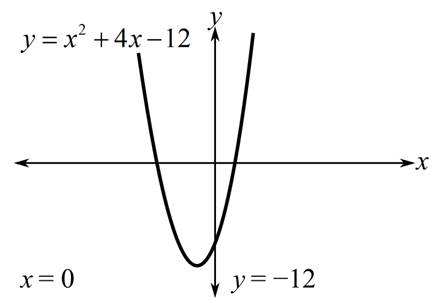
Concept explainers
For Exercises 1– 6, sketch the graph of each parabola. Determine the x- and y-intercepts, vertex, axis of symmetry, focus, and directrix for each.
To graph: The parabola
Explanation of Solution
Given:
The equation is
Graph:
To plot the graph of the function, consider the below mentioned steps and use the Ti-83 calculator:
The standard form of parabola
Step 1:
Press the [Y=] key to enter the equations for
Step 2:
Enter the equations in
Step 3:
Press [WINDOW] key to set the window and then edit the values as follows:
Step 4:
Press the [GRAPH] key to plot the graph.
Step 5:
Press the [TRACE] key to locate the intercept.
The graph thus obtained as follows:

The equation of the parabola
The y-intercept of the equation can be computed by putting the value of x equal to 0 as shown below:
Therefore, the y-intercept is
The x-intercept of the equation can be computed by putting the value of y equal to 0 as shown below:
Therefore, the x-intercepts are
The vertex in the equation of the parabola
Therefore the vertex of the equation is
The focus of the equation can be computed as
Since, in the equation
Therefore, focus can be written as
The directrix is
The axis of the symmetry for the equation
Hence, the x-intercepts are
Interpretation:
The x-intercepts are
Want to see more full solutions like this?
Chapter 7 Solutions
College Algebra, Books a la Carte Edition, plus NEW MyLab Math- Access Card Package (6th Edition)
- A research study in the year 2009 found that there were 2760 coyotes in a given region. The coyote population declined at a rate of 5.8% each year. How many fewer coyotes were there in 2024 than in 2015? Explain in at least one sentence how you solved the problem. Show your work. Round your answer to the nearest whole number.arrow_forwardAnswer the following questions related to the following matrix A = 3 ³).arrow_forwardExplain the following termsarrow_forward
- Solve questions by Course Name (Ordinary Differential Equations II 2)arrow_forwardplease Solve questions by Course Name( Ordinary Differential Equations II 2)arrow_forwardInThe Northern Lights are bright flashes of colored light between 50 and 200 miles above Earth. Suppose a flash occurs 150 miles above Earth. What is the measure of arc BD, the portion of Earth from which the flash is visible? (Earth’s radius is approximately 4000 miles.)arrow_forward
- e). n! (n - 1)!arrow_forwardSuppose you flip a fair two-sided coin four times and record the result. a). List the sample space of this experiment. That is, list all possible outcomes that could occur when flipping a fair two-sided coin four total times. Assume the two sides of the coin are Heads (H) and Tails (T).arrow_forwarde). n! (n - 1)!arrow_forward
- Algebra & Trigonometry with Analytic GeometryAlgebraISBN:9781133382119Author:SwokowskiPublisher:Cengage
 Elementary AlgebraAlgebraISBN:9780998625713Author:Lynn Marecek, MaryAnne Anthony-SmithPublisher:OpenStax - Rice University
Elementary AlgebraAlgebraISBN:9780998625713Author:Lynn Marecek, MaryAnne Anthony-SmithPublisher:OpenStax - Rice University College Algebra (MindTap Course List)AlgebraISBN:9781305652231Author:R. David Gustafson, Jeff HughesPublisher:Cengage Learning
College Algebra (MindTap Course List)AlgebraISBN:9781305652231Author:R. David Gustafson, Jeff HughesPublisher:Cengage Learning


